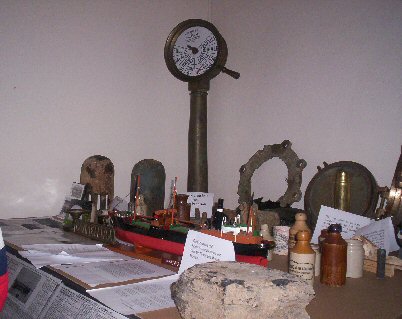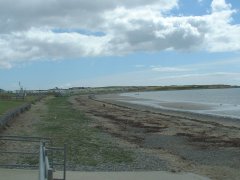The fateful year of 1916 will long be remembered in world history. The Great War – the war to end wars – exacted a terrible toll in young men’s lives, especially at the Somme in France where in one day alone, 1 July, 19,000 young British troops – many of them, indeed, Irish (no part of Ireland was free then), some from Ulster and many from other parts of Ireland – perished in a fruitless attempt to relieve the French.

Many young men, and some women too, enlisted in the forces – from patriotism, or because it was a job, or just for the chance to fight the Kaiser. Others emigrated in search of a better life abroad. Despite wartime conditions ordinary people got on with their lives. War made labour more valuable. In Newry, some few got work in shipping or at the dockside.
In Dublin a small band of rebels following the dictum that ‘England’s difficulty is Ireland’s opportunity’ rose in rebellion. Five years later a Free State was won and a generation later an Irish Republic was proclaimed. These latter events are commemorated or celebrated as central in history. Yet before the long-protracted Battle of the Somme finally concluded, a shipping disaster – now largely forgotten – at the Bar of Carlingford Lough claimed almost a hundred innocent lives – most of them young locals emigrating in search of a better life abroad. This article is a tribute to them.
Mr P Kearney, National Schoolteacher at Whitecross had a sizable adult family. On Friday 3 November his son, Mr. P J Kearney was waiting with his sister Katherine at Newry’s Edward Street railway station for the boat train to Greenore. They were sailing on to Holyhead, and then to Liverpool where they hoped to meet a sister just returned from America. A ‘returned Yank’ was cause for great family celebration since most emigrants were gone forever. Sgt Fitzpatrick of the RIC was on train duty at the station and he advised that in all probability the boat would not sail because the weather was so wild. He advised them to go by Dublin.
Mr. Kearney hesitated and then said he would abide by the spin of a coin. He spun the penny and on the result decided to go by Greenore. The policeman again advised against such a decision. Mr. Kearney pointed out that a relative was meeting the Greenore boat and he would not like to disappoint this person.
Less than twelve hours later and just twelve miles away, P J Kearney’s body was washed ashore at Cranfield.
Many of the bodies washed ashore on that fateful night were so badly battered that they were dismembered, mutilated and unrecognizable. Miss Kearney’s body for example, was never found intact to be identified. In place of the intended banquet in her honour, the returned sister was compelled some four days later to attend the sad funeral service at Tullyherron of her two siblings.
All told there were nine crew – most of them from Newry – on the collier The Retriever that hauled coal from Garston to Newry. James Boyle, a young man of 21 from Warrenpoint worked in the hold. Because of the storm Captain O’Neill himself chose to steer that evening. The chief engineer was John Stuart of Bridge Street. Edward Mullan of Castle Street was second engineer and William Clugston of Boat Street was first mate, while Samuel McComb of Queen Street was fireman. Months later at the inquest, the only survivor James Boyle – a non-swimmer – gave the following testimony.
‘We left Garston at 4.25 on Friday. The wind was southeast with a moderate breeze. About noon, the wind rose and came from the south-southwest. Approaching the Lough, our cargo shifted because of the storm but not so as to seriously affect steering. A passenger boat from Greenore was emerging from the Lough as we approached the Haulbowline Lighthouse. It was blowing heavily. We got our light up. I had to leave the deck to go to the Captain’s cabin. I heard a collision. While below I heard three short blasts from our boat’s whistle and the ringing of the telegraph, indicating that we were about to go astern. I rushed on deck to see the Connemara [the passenger ship] right across our bows. The two boats were then in contact. There was a heavy sea. The Retriever came clear of the Connemara and grounded on the north side of the channel.’
In answer to questions, Boyle denied that their cargo had further shifted. He saw the Connemara sink into the waves. It sank in about seven minutes. The Retriever attempted to launch a lifeboat. He was one of the hands at this job.
The Retriever listed to starboard and the lifeboat was flung into the sea. He had a firm hold of a rope and swung into the boat. The Retriever listed again and went down. He was alone in the lifeboat. He saw no more of the crew after that. Despite the strong tidal pull here at the Carlingford Bar, the boat was propelled shoreward by the storm but trice capsized over this short 200 metres distance. The waves washed him onto the keel to which he clung. When he reached the surf he crawled in on his hands and knees. Someone came to his aid.
Carrying 51 passengers, a crew of 31 and three cattlemen the Connemara left Greenore as usual shortly after 8 o’clock on Friday night. The wind was then blowing with hurricane force but the passengers were in excellent spirits. The vessel was only 2-3 miles out when The Retriever was sighted and a few minutes later there was a tremendous collision. The Retriever had suddenly veered to starboard striking the passenger vessel amidships. With a big gaping hole in her sides, she sank immediately.
The lighthouse man witnessed this and gave the alarm. Peter Morgan, a pilot who lived close to Cranfield shore heard the fog signals and rushed to a neighbour William Hanna for support. They found a copious quantity of wreckage washed ashore and several dead cattle. Then one of the watchers discerned a crouching figure struggling laboriously through the white surf. There was a short, sharp cry for help. Mr. Hanna, wading through the water up to his waist, succeeded in bringing Boyle ashore.
Everyone helped in the aftermath but no other lives were saved and a total of ninety-three souls perished on that fateful night. Local farmers willingly assisted in the removal of bodies to a makeshift mortuary some two miles away. The bodies were placed reverentially side-by-side awaiting identification.
The most harrowing of stories abounded. One of the women washed ashore was clinging to a little blue-eyed baby. Even in death, it was difficult to get her to relax her hold.
One of the most pathetic of the many painful scenes that occurred was played out on Sunday afternoon when an old man from Crossmaglen, passing along the row of corpses, with their upturned faces, recognized his daughter. Unable to control his grief, he fell down beside her, exclaiming from the depths of his heart, ‘Oh, my child! My poor child!’
She had set out in search of a better life abroad. He covered her face with kisses and had eventually to be gently removed from the shed.
A woman passenger was on her way to England with her three children to welcome her soldier husband home from the front. Private McKenna – previously of the RIC – had been twice wounded in action and was only recently discharged from hospital. Three or four soldiers, veterans of the European campaigns were on board. The stewardess was a Miss Williams, soon to be married. She was on her last trip before her resignation.
Seventeen young women on board were travelling via Liverpool to Canada where they intended to enter domestic service or do farm work.
The stretch of sand that makes Cranfield our most popular beach was all too short for the victims of this disaster. Almost all the bodies – animal as well as human – were smashed against the nearby rocks . There were men whose heads had been wrenched from their bodies, women whose arms or legs were missing and poor little helpless children whose features had been horribly bruised and mutilated.
At low tide on the following Sunday, in calm weather and wintry sunshine the two vessels could be seen lying at little more than a stone’s throw from the beach. The Connemara with her sides clearly exposed above the water was directly opposite Peter Morgan’s house. The Retriever was fifty yards away slightly towards the Louth coast. Apparently after the collision the Retriever reversed its engines and went astern. Only one out of ninety-four souls survived. Some seven cattle made it ashore alive.
For days afterwards the newspapers carried disturbing descriptions of bodies lately washed ashore.
‘Body of a soldier badly mutilated and not recognizable:
body of a boy, about 12 years of age, naked and unrecognizable:
body of a baby, about 6 months old, wearing a white lace pinafore, blue print dress and bonnet:
body of a woman, 25 years of age, wearing on third finger of right hand a ring with little stone in centre, fair hair.’
Five Newrymen had a common funeral procession when the whole town turned out in tribute.
‘Then came the five hearses, each followed by a knot of immediate relatives (a number being in khaki) and a long line of mourning carriages. Among the spectators was James Boyle, who when he was recognized had to beat a hasty retreat from admiring crowds. On the way to the Old Chapel the cortege wound its way through crowds at every street corner. At the High Walk in Chapel Street many availed of the vantage point to observe proceedings. On arrival at the Old Chapel the remains were carried inside and placed on a catafalque before the altar. The sacred building was crowded to suffocation for the service.
At St Patrick’s Churchyard, Stream Street, Newry the body of an unknown soldier who perished in the disaster was buried. Military honours were accorded to the remains. A party of artillery from Dundalk preceded the gun carriage, which was drawn by six horses. A firing party paid the usual honours and the ‘Last Post’ was sounded as the Unknown Soldier was laid to rest.
Our people were united in grief.
In St Mary’s R.C. churchyard, Burren, between the road and the south wall of the church, is the last resting place of Private Frederick Joseph Maginnis of the 16th Batallion, Manchester Regiment. The son of John and Cecilia Maginnis of Corrags, Private Fred Maginnis drowned on the SS Connemara on Saturday 4 November 1916, aged just twenty-three years. There are also gravestones commerating the victims in Dundalk and in Kilkeel.
… Charles McCann drowns at sea ? …
